If you are casting type using American or English machinery, you need a table of points converted into inches. You'd need this even in a perfectly equipped shop which had micrometers which read natively in points, but as such micrometers are scarce indeed, under the assumption that you don't have one (I don't), you'll need such a table constantly.
While direct point-reading measuring tools are scarce in printing (and most typecasting) shops, direct pica-reading tools are common. They tend, though, to be of a semi-precision variety (e.g., the printer's line gauge, or "pica stick"). Once common tools such as the typefounder's "72 point gauge" (which is really just a "6 pica gauge," of course) are now scarce. The most accurate pica-reading tool in an ordinary printing shop (at least a hot metal shop) might well be the gauge on the printer's saw.
This may be adequate for the printer, but it is not sufficient for the typefounder (or indeed the linecaster). The typefounder needs to be able to replicate the "72 point gauge" using common inch measuring tools (micrometers and calipers). The linecaster preparing cast borders for sale needs to know exactly how long a cut slug is, not roughly to the pica as shown on a pica stick, but exactly to the fractional pica (measured with the only tool available - an inch-reading vernier, dial, or digital caliper).
These tables could have gone in several different sections of CircuitousRoot. Indeed, I most often use them when casting type on a sorts caster, so perhaps I should have put them in one of the Noncomposing Typecaster Notebooks. They might also reasonably have gone in one of the Type Machinery Operation Notebooks. They had to go somewhere, though, so they are here.
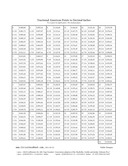
To 24pt by 1/8 points, 5-place
Fractional American Points to Decimal Inches, from 0 to 24 points by eighth points, expressed to five decimal places (rounded, not truncated). Clicking on the image here gives you a PDF version of this table. Here is the OpenOffice source file for it (but see below for the program to generate its data).
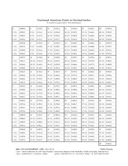
To 48 pt by 1/4 points, 4-place
Fractional American Points to Decimal Inches, from 0 to 48 points by quarter points, expressed to four decimal places (rounded, not truncated). Clicking on the image here gives you a PDF version of this table. Here is the OpenOffice source file for it (but see below for the program to generate its data).
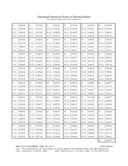
To 48 pt by 1/4 points, 5-place
Fractional American Points to Decimal Inches, from 0 to 48 points by quarter points, expressed to five decimal places (rounded, not truncated). Clicking on the image here gives you a PDF version of this table. Here is the OpenOffice source file for it (but see below for the program to generate its data).
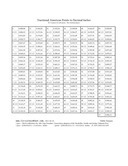
To 72 pt by 1/2 points, 5-place
Fractional American Points to Decimal Inches, from 0 to 72 points by half points, expressed to five decimal places (rounded, not truncated). Clicking on the image here gives you a PDF version of this table. Here is the OpenOffice source file for it (but see below for the program to generate its data).
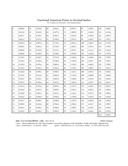
To 144 pt by whole points, 4-place
Fractional American Points to Decimal Inches, from 0 to 144 points by whole points, expressed to four decimal places (rounded, not truncated). Clicking on the image here gives you a PDF version of this table. Here is the OpenOffice source file for it (but see below for the program to generate its data).

ATF Points to 4 Places
"ATF Standard Table of Points and Inches." (Elizabeth, NJ: American Type Founders, Inc., n.d.) Thanks are due to Stephen O. Saxe for providing the photocopy from which I made this scan.
The icon links to a PDF version which has been rotated and cropped a bit, and converted (inside the PDF) to JPEG. Here is the original scan, as a 600dpi greyscale PNG image: atf-standard-table-of-points-and-inches-photocopy-via-saxe-0600grey.png
Note that Theo Rehak, in Practical Typecasting, reproduces a earlier table which goes out to more decimal places.

Mergenthaler Linotype Points
Mergenthaler defined the point as 0.014 inch exactly. (This is infinitely (literally) more sensible than Adobe's ignorant redefinition of the point as an infinitely repeating fraction of an inch, 0.0138,888,...) Here is a table comparing Mergenthaler Linotype points to typefounders' points, for every value of the Linotype knife block. It is a quick-and-dirty LibreOffice spreadsheet. The icon links to a rendered PDF. Here is the source: mlcpoints.ods
Here are two pica conversion tables. These are simply LibreOffice spreadsheets. I've computed them up to 36 points only, as 6-inch calipers are common, but you could easily extend them.
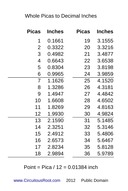
Whole Picas to Decimal Inches
1 to 36 picas, by whole picas, in decimal inches.
Here is the LibreOffice spreadsheet source: whole-picas-to-decimal-inches-01-36-table.ods.

Fractional Picas to Decimal Inches
1/2 to 36 picas, by half picas, in decimal inches.
Here is the LibreOffice spreadsheet source: fractional-picas-to-decimal-inches-00-36-table.ods.
Use this command to compile it: cc -lm -o pointchart pointchart.c
usage: ./pointchart LessThanPoint DivisionsPerPoint Places NumColumns
LessThanPoint must be a reasonable integer.
DivisionsPerPoint must be 0, 2, 4, or 8 for whole points, half points, quarter points, or eighth points, respectively.
NumColumns may fail for extreme values.
The output is a sort of a "comma separated value" list (redirect it to a file), save that the separator is a semicolon rather than a comma (the comma is used as the thousands separator in the decimals). The format is American, with a period for the decimal point. Fractional points are expressed as fractions in ASCII text.
You could import the output into a spreadsheet. I find spreadsheets to be fairly limited in terms of features to make the table look pretty, though. What I did to create the tables here was to import the output file into OpenOffice Writer (Insert -> File). I then highlighted the table and used Table -> Convert -> Text to Table. I added the final value (e.g., 24 point, 48 point) by hand. (The program calculates from zero up to but not including the final integral value. This is necessary to get a nice table which divides up so that integral values head each column.) Then I fiddled with the formatting. The typeface is Linux Libertine, which is reasonably nice.
The ATF point chart was published in the US without copyright notice at a time when such notice was required to secure copyright. It therefore passed into the public domain upon initial publication. This digital reprint remains in the public domain.
The tables here (in any form, whether CSV, ODS, ODT, PDF or other) are in the public domain. The program which generates the table data, pointchart.c, is licensed under the GNU General Public License version 3.0 or greater.
All portions of this document not noted otherwise are Copyright © 2011-2012 by David M. MacMillan and Rollande Krandall.
Circuitous Root is a Registered Trademark of David M. MacMillan and Rollande Krandall.
This work is licensed under the Creative Commons "Attribution - ShareAlike" license. See http://creativecommons.org/licenses/by-sa/3.0/ for its terms.
Presented originally by Circuitous Root®
Select Resolution: 0 [other resolutions temporarily disabled due to lack of disk space]